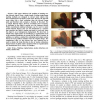Free Online Productivity Tools
i2Speak
i2Symbol
i2OCR
iTex2Img
iWeb2Print
iWeb2Shot
i2Type
iPdf2Split
iPdf2Merge
i2Bopomofo
i2Arabic
i2Style
i2Image
i2PDF
iLatex2Rtf
Sci2ools
118
Voted
SIGGRAPH
2010
ACM
2010
ACM
Motion regularization for matting motion blurred objects
Abstract-- This paper addresses the problem of matting motion blurred objects from a single image. Existing single-image matting methods are designed to extract static objects that have fractional pixel occupancy. This arises because the physical scene object has a finer resolution than the discrete image pixel and therefore only occupies a fraction of the pixel. For a motion blurred object, however, fractional pixel occupancy is attributed to the object's motion over the exposure period. While conventional matting techniques can be used to matte motion blurred objects, they are not formulated in a manner that considers the object's motion and tend to work only when the object is on a homogeneous background. We show how to obtain better alpha mattes by introducing a regularization term in the matting formulation to account for the object's motion. In addition, we outline a method for estimating local object motion based on local gradient statistics from the original imag...
Computer Graphics | Fractional Pixel Occupancy | Matting | SIGGRAPH 2010 | Single-image Matting Methods |
Related Content
| Added | 06 Dec 2010 |
| Updated | 06 Dec 2010 |
| Type | Conference |
| Year | 2010 |
| Where | SIGGRAPH |
| Authors | Hai Ting Lin, Yu-Wing Tai, Michael S. Brown |
Comments (0)

